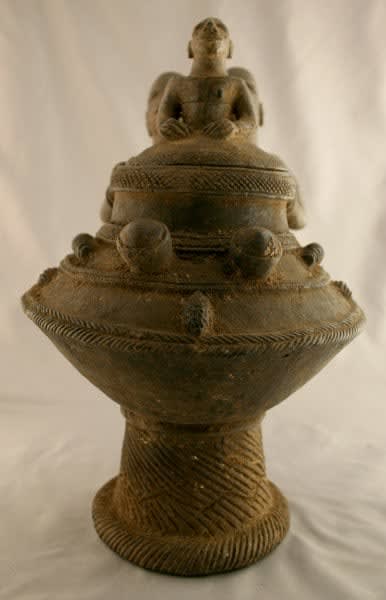Mangbetu Terracotta Vessel, 20th Century CE
Terracotta
7 x 12.25 x 9.25
CK.0337
Further images
The Mangbetu moved to the Congo region from Sudan in the 1700s, and live in societies that revolve around a court system. They are particularly renowned for their professional musicians,...
The Mangbetu moved to the Congo region from Sudan in the 1700s, and live in societies that revolve around a court system. They are particularly renowned for their professional musicians, and also for their extravagant dancing and ceremonial pageantry. Their artworks were produced for the royal court families, and ranged from architecture to objects of religious/spiritual significance and secular items decorated with pleasing motifs and designs.
Mangbetu art is perhaps most recognizable for the inverted-cone coiffures of the (usually female) figures that tend to adorn it. This is seen in the rare wooden figures, as well as in ceramics. The coiffure – exaggerated by cranial deformation during infancy – was worn by women until the 1950s. Most of the pieces found their way to the royal courts. Kings were originally believed to be semi-divine, able to control natural resources using magical objects such as leopard parts. Mangbetu resistance to European rule had serious socioeconomic repercussions, but by the time that the European hold on the area had solidified, the Mangbetu were in the habit of trading and exchanging prestige goods – notably ornate ceramics – between chiefly courts and to colonials.
The role of these pieces is uncertain. The Mangbetu creator god is named Noro (also Kilima), but there is little sculptural abstraction in Mangbetu art that hints at an aim beyond the representational, or the secular decorative. They may also represent ancestors, which the kings usually command be revered. It is possible that the decorations on such pieces are designed to repel the negative effects of ‘Likundu’ – evil spirits – or witchery, which is a major concern in Mangbetu society.
Mangbetu art is perhaps most recognizable for the inverted-cone coiffures of the (usually female) figures that tend to adorn it. This is seen in the rare wooden figures, as well as in ceramics. The coiffure – exaggerated by cranial deformation during infancy – was worn by women until the 1950s. Most of the pieces found their way to the royal courts. Kings were originally believed to be semi-divine, able to control natural resources using magical objects such as leopard parts. Mangbetu resistance to European rule had serious socioeconomic repercussions, but by the time that the European hold on the area had solidified, the Mangbetu were in the habit of trading and exchanging prestige goods – notably ornate ceramics – between chiefly courts and to colonials.
The role of these pieces is uncertain. The Mangbetu creator god is named Noro (also Kilima), but there is little sculptural abstraction in Mangbetu art that hints at an aim beyond the representational, or the secular decorative. They may also represent ancestors, which the kings usually command be revered. It is possible that the decorations on such pieces are designed to repel the negative effects of ‘Likundu’ – evil spirits – or witchery, which is a major concern in Mangbetu society.









